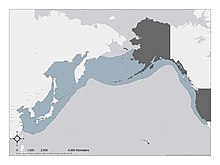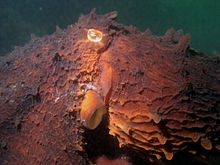Note: there is a graphic below of the Giant Pacific Octopus range near the bottom of this page which should enlarge if you click on it.
The giant Pacific octopus (Enteroctopus dofleini, formerly also Octopus apollyon), also known as the North Pacific giant octopus, is a large marine cephalopod belonging to the genus Enteroctopus. Its spatial distribution includes the coastal North Pacific, along Baja California, California, Oregon, Washington, British Columbia, Alaska, Russia, Eastern China, Japan, and Korean Peninsula.[2] It can be found from the intertidal zone down to 2,000 m (6,600 ft), and is best adapted to cold, oxygen-rich water. It is the largest octopus species, based on a scientific record of a 71-kg (156-lb) individual weighed live.[3]
Description
Size
E. dofleini is distinguished from other species by its large size. Adults usually weigh around 15 kg (33 lb), with an arm span up to 4.3 m (14 ft).[4] The larger individuals have been measured at 50 kg (110 lb) and have a radial span of 6 m (20 ft).[2] American zoologist G.H. Parker found that the largest suckers on a giant Pacific octopus are about 6.4 cm (2.5 in) and can support 16 kg (35 lb) each.[2] The alternative contender for the largest species of octopus is the seven-arm octopus (Haliphron atlanticus) based on a 61-kg (134-lb) incomplete carcass estimated to have a live mass of 75 kg (165 lb).[5][6] However, a number of questionable size records would suggest E. dofleini is the largest of all octopus species by a considerable margin,[7] including a report of one up to 272 kg (600 lb) in weight with a 9-m (30-ft) arm span.[8] Guinness World Records lists the biggest as 136 kg (300 lb) with an arm span of 9.8 m (32 ft).[2][9] A UN catalog of octopuses sizes E. dofleini at 180 kg (396 lb) with an arm length of 3 m (9.8 ft).[10]

| |
| Distribution of E. dofleini | |
| Synonyms | |
|---|---|
|


No comments:
Post a Comment